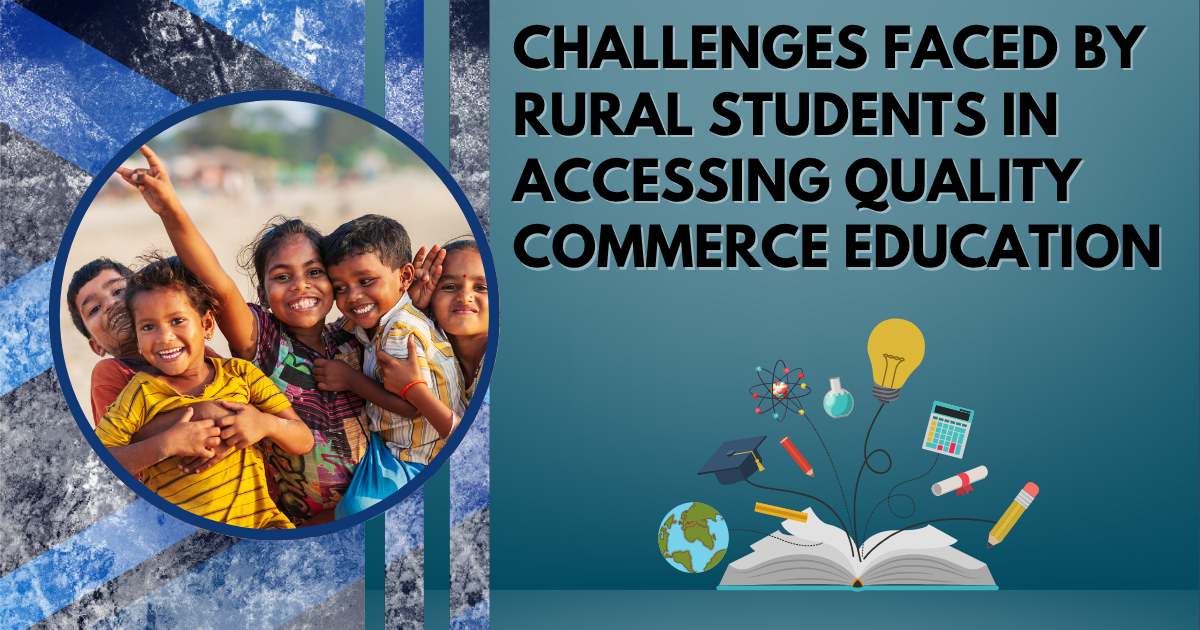Challenges Faced by Rural Students in Accessing Quality Commerce Education. Rural students are not provided with as many facilities as are provided to urban students. They struggle a lot for quality education, as most villages do not have a proper education system or teaching faculty. The teachers are not well educated enough to teach students high-level commerce. Most of the population of India lives in rural areas, and still, they are not as developed as urban areas. To know more about the topic “Challenges Faced by Rural Students in Accessing Quality Commerce Education,” read the complete article.
Challenges Faced by Rural Students in Accessing Quality Commerce Education
There are several challenges that are faced by the rural students in getting quality commerce education. About 67% of the Indian population resides in rural areas. Approximately 196 million elementary school-going children, out of which 146 million are enrolled in rural schools. The school education in rural areas is mostly dependent on government and government-aided schools. The children get primary education but struggle for higher education, especially in commerce. There is no proper faculty in rural areas for high-level commerce education.

Most of the children have to leave their home and get located in urban areas to complete their commerce education. If the villages have a proper education system, then these students will not have to struggle this much. Due to a shortage of dedicated teachers, appropriate textbooks, and opportunities for students to acquire the content in the classroom, quality and access to education are the main concerns in rural schools. Urban and rural students differ from one another not in terms of brain development or starting environments, but rather in terms of abilities, capacity for learning, accessibility to infrastructure, and use of various services.
The main challenges faced by rural students in accessing quality commerce education are
Lack of Infrastructure
In rural areas the infrastructure of schools is not proper. Students do not get a proper environment to get quality commerce education. There is no guarantee of power supply and the environment is not clean. In many schools there is no facility for even clean water. Also, lack of adequate sanitation facilities, especially toilets for girls, leads to high dropout rates among female students.
Quality of Education
This is one of the most significant challenges for rural students is the lack of access to quality education. Digital learning platforms are bridging this gap by offering access to a broad range of educational resources such as video lectures, e-books, and engaging modules. These resources are designed by professional educators and institutions, ensuring that students get a high-quality education irrespective of their geographical surroundings.
Language Barriers
Rural people mostly speak Hindi or their regional language. In the present time, the language that matters the most is English. Priority is given to English and students who are unable to speak English are considered uneducated. Most of the rural students prefer to choose arts or commerce instead of science just to avoid the English language.
Lack of Qualified Teachers
In rural India, the lack of qualified teachers remains a major problem to providing a good education. Many schools face a lack of trained teachers and often rely on unqualified teachers to fill the gap. This affects the learning of students as they have no one to solve their doubts. There is also a shortage of teachers in rural areas, as the qualified teachers do not want to work in rural areas where there are no proper facilities. This blocks the education of students.
Lack of Digital Education
There is no proper facility for digital education in rural areas. Most students do not have a phone or laptop to access digital lectures, digital notes, and online doubt-solving classes. They can not even use AI to study. Commerce education mostly needs theoretical and practical knowledge and they are not able to get quality education due to digital literacy.
Cultural and Social Barriers
Cultural norms and social structures play a significant role in determining educational outcomes in rural India. In many regions, there are conservative attitudes towards education, especially for girls, children with disabilities, and children from lower castes or marginalized communities.
Gender Inequality
Gender inequality is a major barrier in girls’ education. Often boys are sent to school to get a quality commerce education. Girls are forced to do only household duties and are considered a burden on the family. Education for girls is a serious topic. Poor households prioritize boys’ education over girls’.








